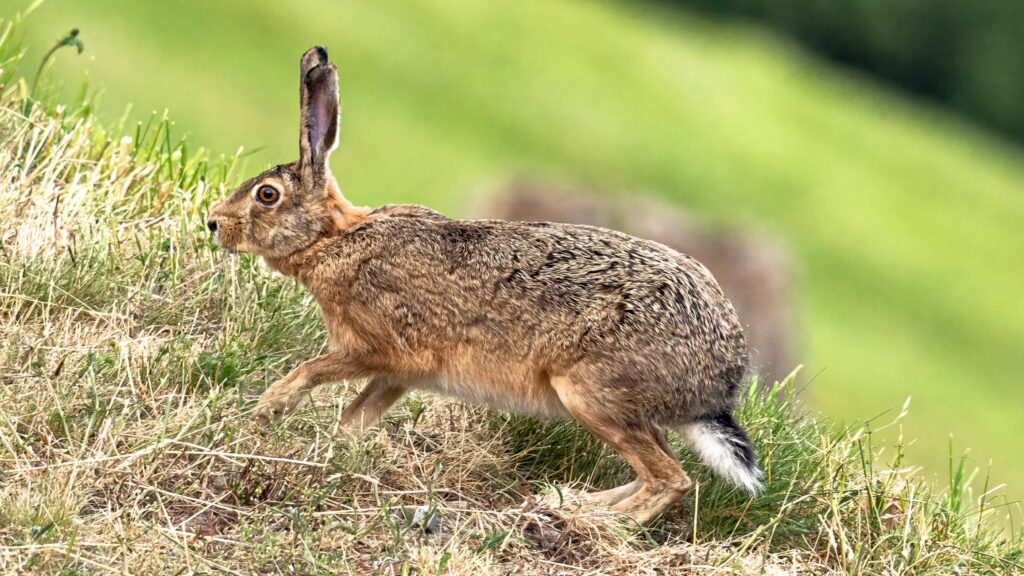
Small game
Small game hunting includes species like pheasants, hares, and other similar game. These animals offer a diverse and exciting hunting experience, often requiring different techniques and equipment compared to larger game.
Habitat
Pheasant
- Location: Forests, including open fields, agricultural lands, and edges of woodlands.
- Environment: Prefers areas with tall grasses, shrubs, and agricultural crops for cover and feeding.
Hare
- Location: Forests, encompassing woodlands, open fields, and agricultural lands.
- Environment: Prefers open fields with dense vegetation for cover and agricultural areas for feeding.
Identification
Pheasant
- Appearance: Male pheasants (roosters) are brightly colored with iridescent plumage, a long tail, and a distinctive red face. Females (hens) are more camouflaged with brown, mottled feathers.
- Size: Weigh between 1-1.5 kg.
Hare
- Appearance: Hares have long ears with black tips, long hind legs, and a brownish-grey coat. They are larger and leaner than rabbits.
- Size: Weigh between 3-5 kg.
Behavior
Pheasant
- Diet: Omnivorous, feeding on seeds, grains, insects, and small invertebrates.
- Activity: Diurnal, most active during early morning and late afternoon.
- Breeding: Breeding season is in the spring, with nests typically hidden in tall grass.
Hare
- Diet: Herbivorous, feeding on grasses, herbs, crops, and bark.
- Activity: Primarily nocturnal, but can be active during dawn and dusk.
- Breeding: Breeding season is from January to August, with multiple litters of leverets (young hares) born each year.
Hunting Seasons and Regulations
Pheasant
- Season: Typically open from October to January. Always check local regulations for specific dates.
- Licenses: Ensure you have the appropriate hunting licenses and permits.
- Bag Limits: Be aware of local bag limits, which can vary.
Hare
- Season: Typically open from October to February. Always check local regulations for specific dates.
- Licenses: Ensure you have the appropriate hunting licenses and permits.
- Bag Limits: Be aware of local bag limits, which can vary.
Equipment
Pheasant
- Firearms: Shotguns (12 or 20 gauge) with appropriate loads (e.g., #5 or #6 shot) are effective for pheasant hunting.
- Dogs: Hunting dogs, such as retrievers or pointers, can greatly enhance the hunting experience by flushing and retrieving birds.
- Clothing: Wear blaze orange for visibility and sturdy boots for walking through fields and brush.
Hare
- Firearms: Small caliber rifles (.22 LR) or shotguns (12 or 20 gauge) with appropriate loads (e.g., #6 or #7.5 shot).
- Dogs: Hunting dogs, such as beagles, can help track and flush hares.
- Clothing: Wear camouflage or neutral-colored clothing to blend into the environment and sturdy boots for walking through fields and brush.
Hunting Techniques
Pheasant
- Walk-Up Hunting: Walking through fields with or without dogs to flush pheasants from cover.
- Stand Hunting: Positioning near known feeding or roosting areas to ambush birds as they move.
- Driving: Organized hunts where hunters drive pheasants toward a line of shooters.
Hare
- Walk-Up Hunting: Walking through fields with or without dogs to flush hares from cover.
- Spot and Stalk: Spotting hares from a distance and carefully stalking closer for a shot.
- Driving: Organized hunts where hunters drive hares toward a line of shooters.
Field Dressing and Meat Care
- Field Dressing: Learn proper field dressing techniques to quickly and efficiently process the deer, ensuring meat quality.
- Transportation: Have a plan for transporting the carcass from the field, whether by ATV, game cart, or manual dragging.
- Processing: Know local facilities for meat processing or be prepared to butcher the deer yourself.
Safety and Ethics
- Safety: Always follow firearm safety rules, wear blaze orange as required, and be aware of your surroundings.
- Ethics: Practice fair chase, ensure a quick and humane kill, and respect all wildlife laws and regulations.
